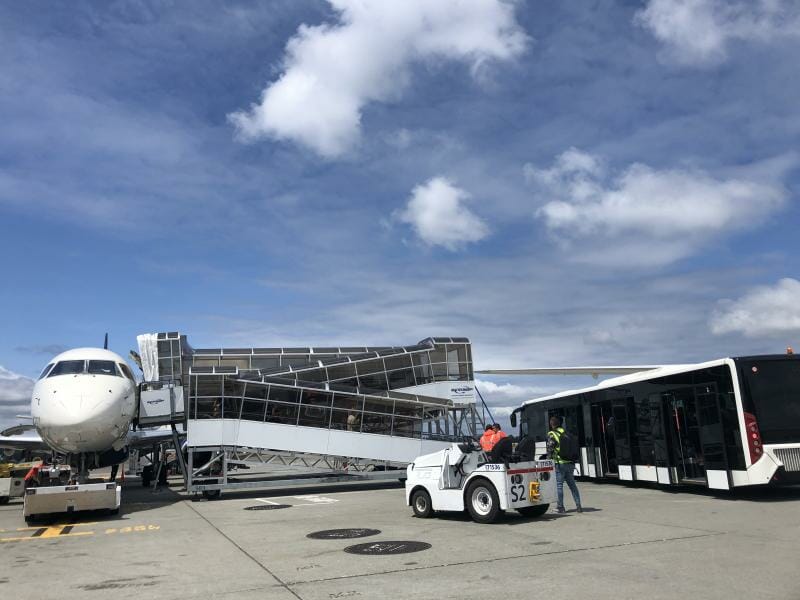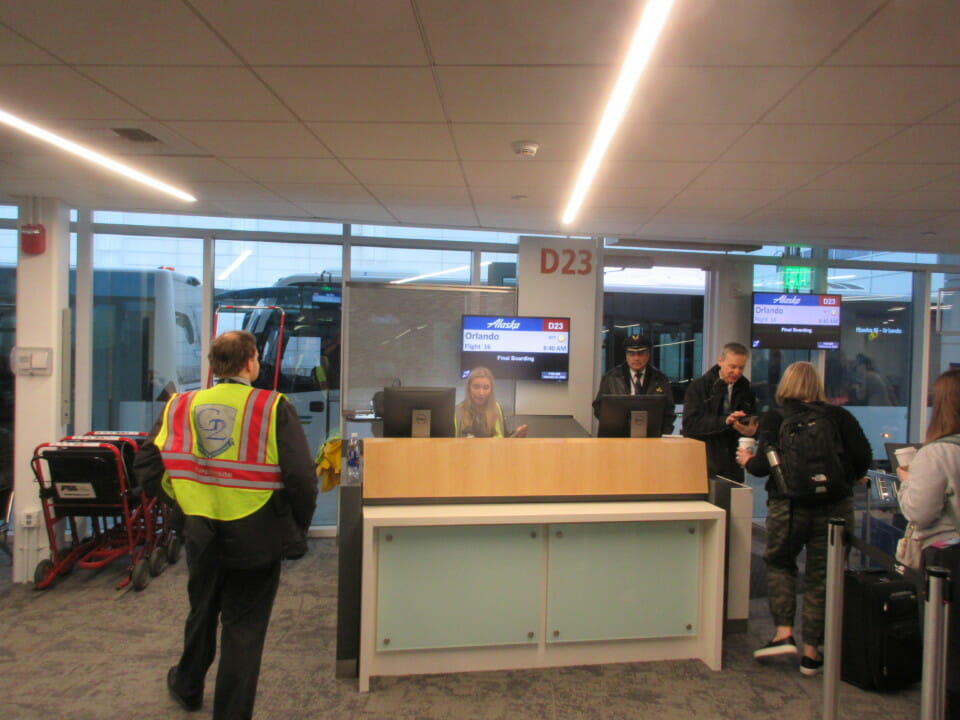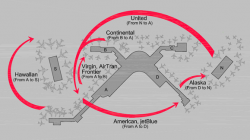Just when I thought things couldn’t get any worse at SeaTac, they got worse. For years I have been putting up with nonstop construction of runways, taxiways and now Concourse D. Please note, this does not affect all flights out of Concourse D.

The Runway And Taxiway Construction
For years, Seattle-Tacoma International Airport (SeaTac) has been undergoing non-stop runway and taxiway construction. This construction has been so disruptive that it has caused air traffic control (ATC) delays for flights departing and arriving at SeaTac. I was at Fort Lauderdale Airport (FLL) last month and will have a two-hour takeoff delay so we could get in the landing queue at SeaTac. Flights are both departing and arriving late at SeaTac. This construction has been going on for years, you would think that after all of this time, they would be done by now.
The North Train Loop
For some time, the train loop that connects the north concourse with concourse D and C was out of service at concourse C. If you had to travel from concourse C to the north concourse of vice versa, you had to walk from C all the way through concourse D to get to the train station. I am happy to report that the train station at concourse C is back open.
New Construction At SeaTac Concourse D
Last week, I was flying first class on Alaska 16 to Orlando International Airport (MCO) with an unfamiliar gate number in concourse D. The first clue that something was up was the fact I was going down to the gate.

Alaska Airlines has a pretty typical boarding process in order of priority:
- Those needing extra time to board the aircraft,
- Families travelling with children under two years of age,
- Active duty military,
- First class,
- Group A,
- Group B,
- Group C,
- Group D and
- Group E.
This sounds rather orderly, right? Wrong! Let’s see what actually happens with the bus trip out to the aircraft.
Organized Mayhem

The whole boarding priority system gets tossed as soon as the airline scans your boarding pass. The “Mayhem Guy” from the Allstate Insurance commercial is on the job here. It doesn’t matter what your boarding priority is because there were four buses used to transport passengers to the aircraft. There are no priority assignments by bus. You get on whatever bus you can fit into and it goes whenever it gets to capacity. You could be a high priority boarding passenger but if your bus is last to arrive at the aircraft, you will be last to board. Shelly and I are flying in first class and we were among the last to get off the bus that arrived second. Here are some photos I took of the boarding process.







The boarding process to get to my seat in row two takes an agonizingly long time. Any attempt of boarding by priority and boarding group is not possible. People sitting in the economy section were able to get o the aircraft first creating a backup down the ramp. It will depend on which bus you can get on and how quickly it can depart to get the aircraft first, or second, or third or fourth.
Here Is What The Port Of Seattle Is Saying
Ground boarding operations
First off, some definitions. What we’re talking about here are called ground boarding operations. Normally when you get on a flight, you are at a gate in the terminal and then you walk down a passenger loading bridge (or PLB) to get in or out of your aircraft. Ground boarding is when your aircraft is parked away from a gate at the terminal, on a specific concrete area, like a big parking lot for planes. From these parking spaces, a shuttle bus loads and unloads passengers from the plane and then drives to special ground boarding gates designed for the shuttles to drop off or pick-up passengers at the terminal.
Ground boarding operations are common throughout the world and are used by more than 300 airports in over 100 countries. If you’ve traveled outside the U.S. you’ve probably seen or been part of a ground boarding operation. Here in the U.S. they are less common, but 21 airports do use some form of ground boarding, so they are not unusual either.
Why is SEA using ground boarding?
Good question. It’s because of the rapid growth at SEA and how busy the gates have become. SEA is a reflection of the growth in our region as our passenger volume has increased 41 percent just in the last five years. With that, plus a number of gates closed due to construction projects (for the North Satellite and International Arrivals Facility), we don’t have enough gates to service all of the flights airlines have scheduled during peak periods.
That’s where ground boarding comes in. Without them, you’d have to wait on your plane for a gate to open or, on the other side, wait in the crowded terminal for the next plane. The demand for gates is extremely high during peak periods, especially mid-day for international flights, and in the morning or evening for domestic flights. Each airline makes the decision to use ground boarding, which may be problematic for their staffing. The busiest airlines lease their own gates and may wait for their own gates to open up rather than move to a common use ground boarding gate. Other airlines, like Norwegian and Frontier, use ground boarding exclusively because they don’t have a leased gate space.
Overall, the number of ground boarding operations at SEA is small, just over one percent in 2018 (5,440 out of 438,391 operations), but we are expecting that to grow to nearly three percent in 2019 (13,500 of an estimated 451,000 operations). Last year we transferred more than half a million passengers on ground boarding shuttle (out of 49.8 million total passengers). In comparison, about six percent of all operations at London-Heathrow or Frankfurt use ground boarding operations.
Some people think a ground boarding operation can be fun. Rather than going through a tube to get to another tube, you actually get to be on the ramp where all the aircraft and activity is going on. You’ll get a chance to see all kinds of planes from the ground, different airline liveries (paint jobs), and see how busy it is to keep all of the flights coming and going with ground workers and services.
What is SEA doing to accommodate airport growth?
SEA opened a new facility to help relieve the congestion, the Concourse D Annex. It’s a two-story facility with six holdrooms, or waiting areas for gates. The building is made specifically for ground boarding operations and provides a more comfortable customer experience than other airports provide for shuttle bus operations. The two story building has skylights, bright open spaces, lots of seating, concessions, electric charging stations, free airport WiFi, restrooms, and even a children’s play area. If your ground boarding shuttle doesn’t end up at the D Annex, you might find yourself at one of our five other locations on Concourse A, B, D or at the South Satellite for international arrivals, which can be found on our interactive map.
The Port of Seattle is currently in the middle of review of a Sustainable Airport Master Plan which recommends 30 near-term projects including a new terminal with 19 gates by 2027.
Do I need to do anything different for a ground boarding gate?
If you find yourself scheduled to go out on any of these gates, there’s nothing more you need to do. Airline staff will direct you through each gate and on to the shuttles. The ride is typically six to eight minutes or less. In fact, unloading, especially large aircraft, is usually faster as ground boarding allows both front and back aircraft exits to be used.
My Take On Remote Boarding
The process is organized mayhem at best. Throw out all ideas of boarding priorities. If you are in a wheelchair, I would get to the boarding area well ahead of the boarding time as they will need to use a ramp to board the bus and another ramp at the boarding ramp.
The Airport spokesman says this process can be “fun” and you will get to see airport operations up close and personal. This is fun that I could easily do without it.
The most important thing is that you will need patience and hope that it is not raining when you get off the bus.
Story Update, March 4, 2020 – Better Results
We connected through Seattle today on our way to Phoenix. The experience today was completely different and felt more under control. What was different today was the fact that Alaska Airlines gate agents only loaded one bus at a time. Actually, they only brought in one bus at a time and the first bus in was the first bus to arrive at the aircraft. This solves the problem of ensuring boarding priority. This is especially true for those who need extra time, those having mobility limitations and families traveling with young children.
I don’t know if Alaska corrected the cattle-car boarding or the Port of Seattle was short on buses today. The end result was that boarding was more orderly and less chaotic. Remote boarding today was certainly an improvement over the last time.


